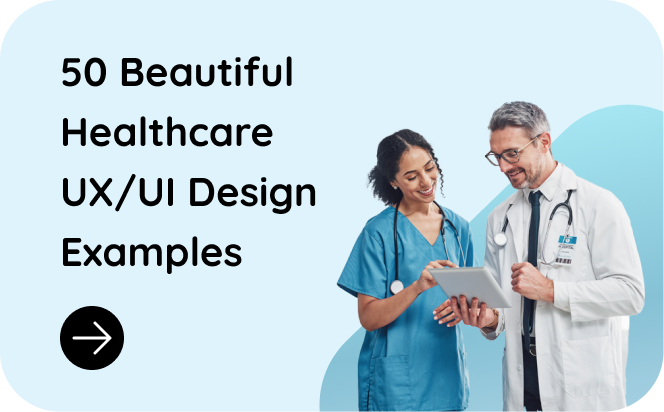In digital healthcare, where precision is paramount and margins for error are razor-thin, one might not immediately equate ‘design’ with ‘life or death.’
Yet, here we are.
Digital healthcare is intricate.
It’s often driven by the minds at the top, those farthest from the daily struggles of healthcare professionals on the ground. And a critical component often overlooked in digital healthcare is the user experience (UX).
➝ UX tends to be sidelined in favor of features, budget constraints, and rapid deployment schedules. Such sidelining suggests that the comfort and efficiency of users come second.
➝ Instead of diving deep into genuine UX research, many digital healthcare platforms prefer the “assumption” approach. This means those crafting the tools make decisions based on what they think users need, rather than soliciting real-world feedback.
➝ The concept of “user-centricity” often becomes too patient-focused, obscuring the vast range of users — from administrative personnel to physicians — each with their unique needs and challenges.
While digital healthcare systems may hit all the marks in a boardroom presentation, they often miss the mark where it counts the most: in a real-world application.
This is why we, at Koru, vehemently argue that in the realm of digital healthcare, lives quite literally depend on design decisions. If product leaders don’t address this, they inadvertently set up hurdles in a system already fraught with challenges, putting both healthcare outcomes and patient lives in jeopardy.
Let’s start with understanding the dilemma.
Three Dimensions to Deciphering the Healthcare UX Design Dilemma
The importance of user experience (UX) cannot be overstated. Yet, numerous challenges plague its implementation in digital healthcare. Delve into the three critical facets— the ailment, diagnosis, and remedy— to comprehend the depth of the healthcare UX design dilemma.
AILMENT: The Diseased State of Healthcare UX Design
What a horror story. '59% of doctors in a Stanford 2018 National Physician Poll said EHRs need a “complete overhaul”' . The systems reduce morale & clinical effectiveness.
— Cruce Saunders (@mrcruce) March 19, 2019
Death, destruction, depression writ across a huge #Healthcare system…all from bad UX & data structures.
The pressing issue of poor UX in healthcare isn’t confined to just patient care. Its tendrils have spread across the whole spectrum, touching on administration, treatment planning, billing, diagnostics, and many other areas. And these elements are intricately linked; a disruption in one can trigger a cascading effect on the others, much like toppling dominos.
Reflect upon these startling real-life scenarios:
- An Ebola patient was mistakenly discharged due to a user interface oversight in the administrative software.
- Tragically, a cancer patient succumbed to complications (toxicity and dehydration). While highly trained nurses grappled with a convoluted monitoring software interface, a vital piece of data was overlooked.
Poor usability of electronic health records (EHRs) is a major factor contributing to patient harm.
Journal of the American Medical Association (JAMA)
Despite the evident life-altering consequences, many healthcare product teams undervalue human-centered design. Current interfaces are often cluttered and inconsistent, drowning professionals in extraneous data. Whether it’s a doctor seeking test results or an executive accessing insurance details, the digital hurdles are significant. Poor UX design isn’t just an inconvenience—it jeopardizes efficiency, safety, and quality. Addressing this necessitates a holistic understanding of UX and its pivotal role across the entirety of healthcare applications. Which brings me to the next point.
DIAGNOSIS: The Digital Health Paradox
Healthcare today, although driven by state-of-the-art technology, often stands riddled with systemic inefficiencies. And a wide range of users in the process bears the brunt of these inefficiencies.
To put it into perspective, consider this:
Hospital administration relies heavily on a host of software systems. From managing the patient journey of thousands who traverse the hospital corridors every day, to ensuring streamlined access to critical documents like EHR, EMR, Continuity of Care Records, and Personal Health Records.
Despite the availability of such systems, a majority of healthcare professionals report challenges in cross-channel integration. This absence of smooth integration, as expected, results in fragmented access to healthcare information and disjointed service workflows. A study mentions that nearly half of healthcare professionals considered EHR systems to add challenges rather than streamline their daily operations. And this is spread across all digital healthcare systems in one way or another. For instance:
Debate in US is often about how expensive our system is. Just as bad is how complicated it is. Private healthcare corps have created the worst UX imaginable. Who actually prefers filing insurance claims and open enrollment to just walking into dr.'s office and getting care?
— Saikat Chakrabarti (@saikatc) February 17, 2019
This digital divide is further intensified by the industry’s bifurcation.
- On one side, we have tech evangelists visualizing a seamlessly connected healthcare environment.
- On the flip side, a significant faction remains deeply rooted in traditional processes, skeptical of the emerging digital landscape.
It’s imperative, thus, that design and digitization in healthcare be an inclusive process. One that not only addresses the needs of today’s digitally native practitioners but also resonates with those who’ve been long accustomed to analog methods. Only then can we hope for a truly integrated healthcare ecosystem?
REMEDY: Designing and Tailoring UX for the Healthcare Warriors
Why is design pivotal?
To quote Jared Spool, design is “the rendering of intent.” Yet, this definition, while precise, seems to skip a beat when we consider its most vital element: users. In the context of digital healthcare, a more fitting description of design would be: “the blueprint that maps technology’s interaction and engagement with its users.”
The healthcare arena is complex and layered with its own set of protocols, terminologies, and dynamics. It isn’t just another sector; it’s a lifeline. While all sectors benefit from the digital revolution, healthcare demands a marriage of innovation with intuitive familiarity.
“Involving end-users in the process is likely important for a successful design and implementation of a performance dashboard within a specific workplace culture.”
BMC Health study
Here are foundational principles for product leaders to guide Healthcare UX design:
Precision Over Proliferation: Think of the design as you would a surgical instrument: sharp, exact, and reliable. Avoid the allure of cramming features; it might prove counterproductive.
Iterative Feedback is Essential: Like the study emphasized, involving end-users is paramount. Their feedback forms the bedrock of truly intuitive and efficient designs.
Fostering Collaboration: A collective effort, comprising IT experts, senior leaders, and all users involved, can be the cornerstone of a cohesive and user-centric design environment.
Four Key Strategies for Product Leaders in Digital Healthcare Development
The digital healthcare landscape is vast and varied, with users from physicians and nurses to administrative staff and beyond. With this diversity comes the imperative for product leaders to ensure that digital platforms like EHRs, telehealth, insurance portals, etc., are universally intuitive and efficient. For product leaders spearheading the development and refinement of these systems, here are four essential practices to help navigate this intricate terrain:
Holistic User Research
Delve deep into the world of every potential user. From understanding the intricacies of an insurance agent accessing patient details to a physician trying to integrate telehealth observations with existing EHR, comprehensive user research is foundational. The more granular your insights, the better you can address specific challenges and pain points.
How to Implement
Start by segmenting your potential users: physicians, administrative staff, patients, etc. For each segment, schedule in-depth interviews and focus group sessions. For instance, while shadowing physicians during their rounds, you might notice how frequently they need to access a patient’s medical history. Recognizing this could guide the development of a quick-access feature in a new EHR system, thus making the physician’s task more efficient.
Streamlined Integration
In the maze of digital healthcare systems, seamless integration is the key. A product leader must ensure that platforms like LIS, EHR, and patient portals ‘speak’ to each other without hitches. This not only enhances user experience but ensures data integrity and reduces redundancy. Remember, in healthcare, disparate systems can lead to life-altering consequences.
How to Implement
Begin with a UX audit or a Heuristic Evaluation of all existing systems in use. Identify common touchpoints or data overlaps. For instance, think of a nurse who inputs patient vitals into an EHR. If they’re later reviewing the patient’s diet on a different platform, they should be able to easily reference those vitals without switching systems. For seamless UX, integrate a feature where vitals can be pulled into the diet analysis system directly. This eliminates the need to switch or duplicate efforts, creating a smoother workflow and better user experience.
Iterative Development
Healthcare is an evolving field, with constant updates in protocols, treatments, and regulations. Adopt an agile development process that allows for frequent iterations. This enables product leaders to swiftly address emerging needs, integrate feedback, and refine systems like telehealth or EMRs in real time.
How to Implement

Adopt an iterative framework like Scrum or Kanban. Begin with shorter development cycles (sprints) of 2-3 weeks. At the end of each sprint, have a review meeting with key stakeholders, like nurses or administrative staff, to demo the developed features. Collect feedback and prioritize it for the next sprint. For example, if during a sprint review, insurance agents highlight that the new claims processing module in the system lacks an efficient search feature to quickly retrieve specific patient records, prioritize its development in the next cycle.
Ideating, Validating, Testing, And Refining Healthcare Design Concepts
It’s prudent to identify potential design flaws early. The best way to validate your ideas is through rigorous testing, prototyping, and even basic models for swift idea development and validation. You need to refine design concepts based on actual test results and the hypothesis.
According to a National Library of Medicine study, administrative inefficiencies contribute to roughly $265.6 billion wasted in healthcare annually.
Rapid Prototyping allows you to build and test different iterations of your healthcare application swiftly and address the inefficiencies early on.
How to Implement

Brainstorm potential design ideas and quickly transform them into low-fidelity prototypes. Organize usability testing sessions with diverse users such as lab technicians or billing clerks. Observe their interactions, and gather feedback. For instance, if administrative staff struggle with a newly designed patient check-in procedure on a prototype, refine the design based on their suggestions before moving to the development phase.
The Underrated Catalyst in Healthcare Evolution
We do not imply that enhancing UX in digital healthcare would single-handedly resolve the multifaceted challenges this sector confronts. The entire structure of the healthcare industry is shaped by myriad external factors and stakeholders, each contributing to its complexity.
However, undeniably, a well-crafted user experience can be transformative. By establishing an intimate understanding of end-users, UX offers a pivotal path to craft tailored solutions. As we advance, it’s paramount to harness good UX not as an afterthought, but as a cornerstone, driving more effective care delivery and optimizing medical outcomes. The journey to refining healthcare, while intricate, must be anchored in user-centric design.










